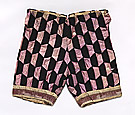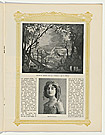Giselle
Fantastic ballet in two acts
- Producer: Les Ballets Russes de Serge Diaghilev
- Premiere: 17 June 1910, Théâtre national de l’Opéra, Paris
- Costume design: Alexandre Benois
- Scenery design: Alexandre Benois
- Music: Adolphe Adam
- Choreography: Michel Fokine, after Jean Coralli and Jules Perrot
- Libretto: Vernoy de Saint-Georges, Théophile Gautier, Jean Coralli
- Main characters: Giselle, Duke Albrecht of Silesia (Loys), Hilarion, Duke of Courland, Princess Bathilde, Bathilde’s page, Giselle’s mother, Prince of Houston, Peasant girl, Valet, Buffoon, Myrtha, Queen of the Wilis
The ballet is set in a small village in the Rhineland, Germany in the early nineteenth century, where Albrecht, the Duke of Silesia, masquerades as a peasant under the pseudonym of Loys. Although he is already engaged to Bathilde, daughter of the Prince of Courland, he flirts with the mentally unstable Giselle. Hilarion, a local huntsman in love with Giselle, unsuccessfully attempts to dissuade her from forming an attachment with Loys. Following the arrival of Bathilde and her father’s hunting party, Giselle discovers Albrecht’s deception and, distraught, stabs herself in the heart. In the second act, Giselle haunts the forest with the Wilis, the vengeful ghosts of women who have died before their wedding day. First Hilarion, and then Albrecht, who has realised that he too loved Giselle, enter the forest to pay their respects at her grave. Hilarion is killed by the Wilis, who force him to dance himself to death, but with Giselle’s intervention, Albrecht manages to escape. The ballet ends with Giselle returning to the peace of her grave, onto which Albrecht throws himself in despair.
Giselle, the best known of the Romantic ballets, was first produced by the Paris Opéra on 28 June 1841. Marius Petipa’s 1884 revival for the Imperial Ballet, and Anna Pavlova’s 1903 debut in the title role, defined its modern style. Its 1910 production by the Ballets Russes, with Tamara Karsavina’s and Nijinsky’s commanding presences as Giselle and Albrecht, brought it to the Western stage for the first time. Its light and ethereal costumes for the female dancers, following the long tutu style made fashionable by Marie Taglioni in La Sylphide of the 1830s, are set within an overall costume ensemble reflecting the story’s historical setting in the Rhineland of the sixteenth century. Albrecht’s mourning costume of black, slashed and puffed velvet doublet and trunk hose, over a white square-necked shirt, was designed as a dramatic contrast to Giselle’s pale spectre in their final scenes
of reconciliation.





